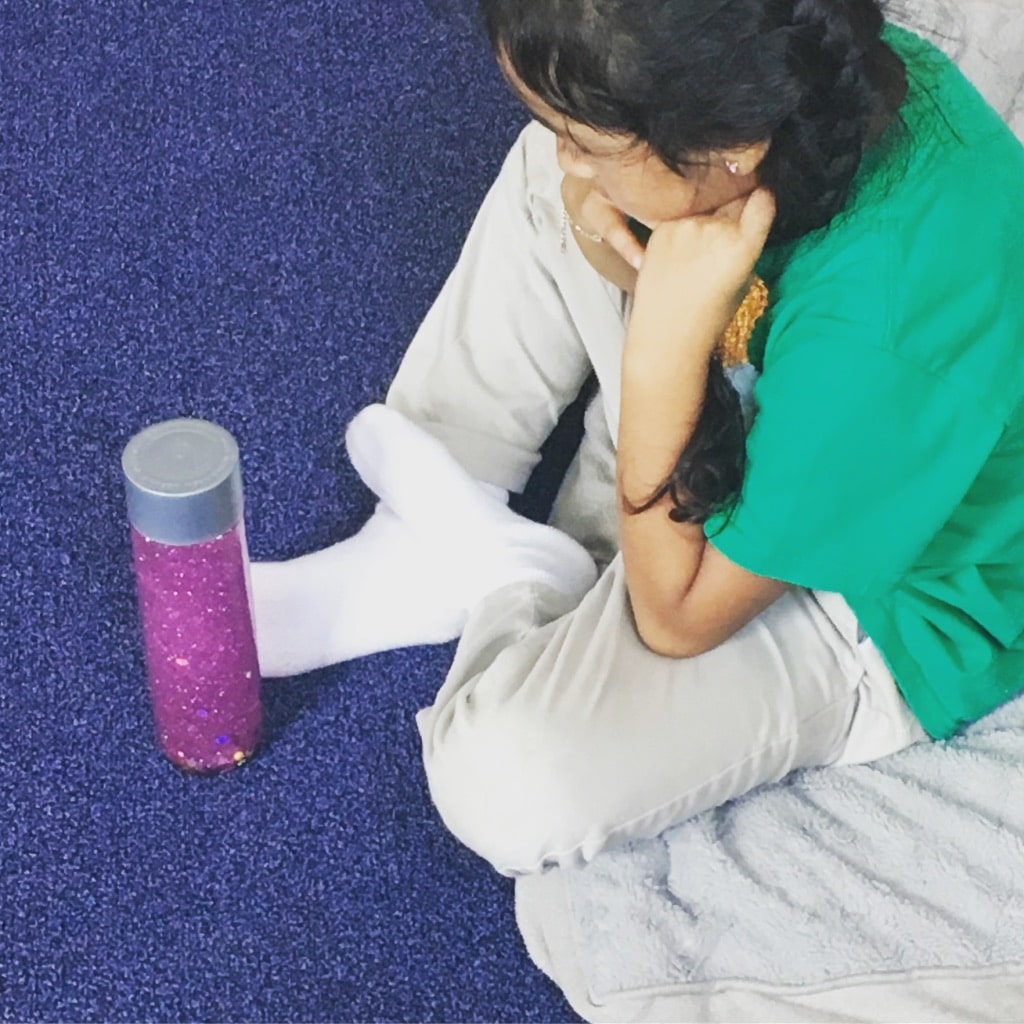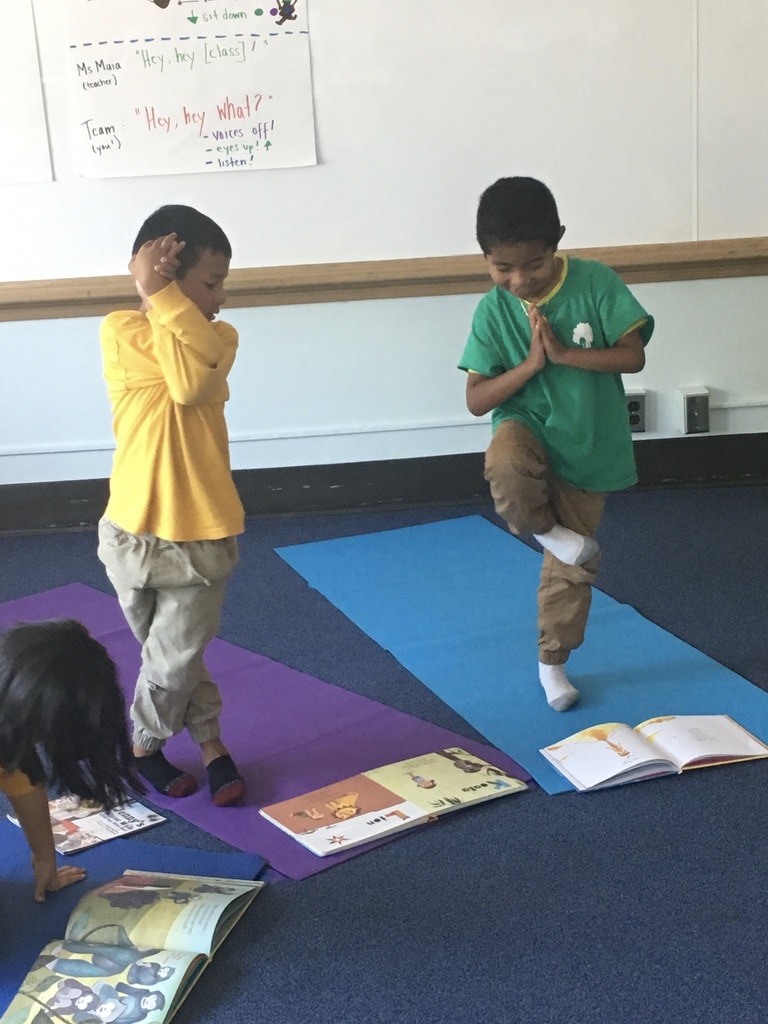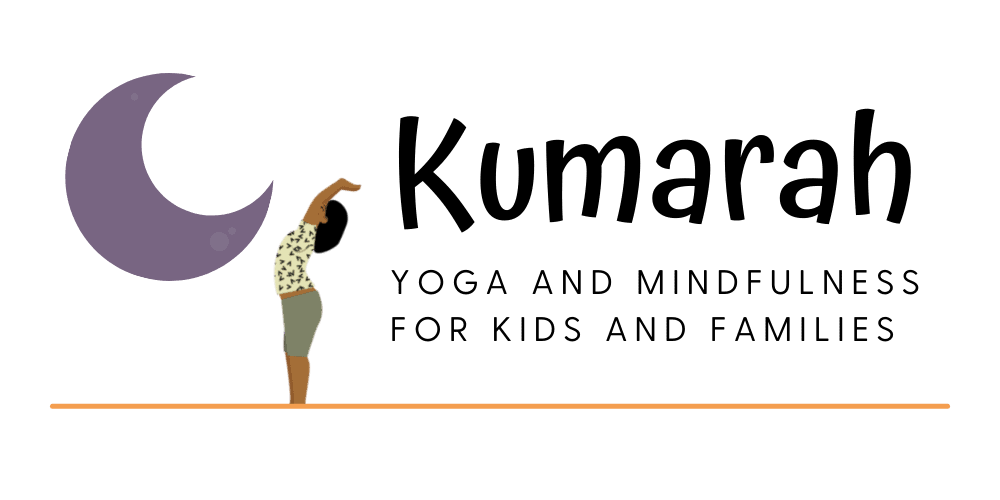School can be hard for many kids, with the high amounts of school work, extended time sitting, and social pressures that can cause anxiety and stress.
Introducing yoga to kids in a school classroom can be a great way for teachers to help lighten the mood and alleviate stress for their students. The ancient practice of yoga, with its emphasis on physical postures, breathing techniques, and mindfulness, offers tons of benefits that support children’s overall well-being and development.
Plus, yoga for kids is really fun!
By incorporating yoga into a daily routine at school, educators can help their students learn resilience, emotional intelligence, and have fun by doing something different with their time.
In this article, we will learn a little about why yoga works to help kids in a classroom, and some practical tips for how to add yoga sessions into your school day with your students.

The Benefits of Yoga for Kids in a Classroom
Yoga is not just for adults; it can be equally beneficial for children with the right support and teaching techniques. As the educational landscape evolves, there is a growing recognition of the importance of holistic approaches to learning.
Not only can yoga and mindfulness be taught in many schools as part of the regular curriculum, there are even districts that have mindfulness and meditation practices as a tool in place of detention or suspension.
Yoga provides a unique opportunity for kids to connect with their bodies, minds, and emotions in a non-competitive and low-risk environment. It’s also lots of fun.
Mindfulness, or focused awareness, helps kids learn to concentrate and tune in to what’s most important in the present moment (which helps with learning!)
Physical Benefits of Yoga for Kids
- Yoga poses are simple and fun new ways for kids to move and develop spatial awareness
- Many poses help kids develop flexibility, strength, and balance
- Balance poses can enhance kids’ posture, coordination, and core strength
- Regular yoga practice can contribute to better body control and awareness and increased (or stabilized) energy levels
Emotional Regulation
- Yoga encourages children to explore and express their feelings in a safe space
- Breathing exercises and relaxation techniques help kids learn to handle stress and anxiety more effectively
- Trying new poses with the aim of improvement helps kids build resilience and grit
Improved Concentration and Focus
- The mindfulness aspect of yoga teaches children to be present and fully engaged in the moment
- Learning new poses by watching an instructor helps improve focus and mind-body connection
- Mindfulness activities in yoga and meditation are easily transferable to classwork and can help kids increase their focus on schoolwork as well
Enhanced Self-esteem and Confidence
- Yoga is a non-competitive practice that celebrates individual progress and growth
- As kids master new poses or improve their techniques, they experience a boost in self-esteem and confidence, fostering a positive self-image

Cultivation of Empathy and Compassion
- Through partner yoga and group activities, children learn to work together and support one another
- While working on their own poses and postures and celebrating growth, they will start to see and recognize achievements in others as well, helping them develop empathy
Implementing Yoga in the School Classroom
How do you get started with yoga in your classroom? The best technique is to start small, but be consistent and intentional (like you always are in your classroom 🙂)
Create a Welcoming Space or Ambiance
You probably don’t have a lot of extra space in your classroom. However, if you have a calm down corner or Take a Break space, this can be modified to create a little yoga space for some individual yoga exploration.
Put out a yoga mat (and maybe a mirror), some yoga books, a few fidget toys or a Hoberman sphere. Then, post up some yoga pose cards that kids can practice on their own in that space. A Glitter Calm Down Jar works wonders in this space as well!

Otherwise, if you are doing yoga as a whole class, you can set the ambiance by dimming the lights, gathering everyone in a circle space or allowing them to move to the side of their desks or even sit on them (during meditation)! Adding some calming music can help too.
Choose a time of day (or transition) to keep it consistent
Maybe you always do a little yoga right after circle time to get kids moving and then focused. Or, use the time between recess and literacy to do a 5 minute stretch and meditation.
Whatever you do, try your best to keep it consistent. There never is enough time in the day to accomplish everything, but adding just 5-10 minutes a day or a week on a consistent basis will help kids get focused quickly on other tasks, thus saving you time in the long run.
When are the best times to do yoga or mindfulness with your students?
- At the start of morning meeting
- And the end of morning meeting
- During story time (add some book-related yoga poses to the story you are reading)
- After a high energy activity like lunch or recess
- Before or after transitions to electives/specials classes
- At the end of week to help process learning or big events
How to Teach Kids in a Classroom Yoga Session
Use Fun Themed-Based Yoga Poses
Tailor the yoga poses and language to suit the age of your students. Yoga doesn’t have to be serious to be effective. Change the name of the poses to animals (if they aren’t already) or other things to fit a theme and make it more interesting to your students.
For younger children, you can make the poses playful, or use creative storytelling to keep them engaged and build literacy skills.
Check out these tips for storytelling yoga with kids, or take a look at all these possible themes you can use with kids.
Add Yoga Poses to your Literacy Block or Story Time
My personal favorite way to add yoga to my classroom is by creating yoga poses that fit a story or book we are reading.
It takes a little creativity, and a bit extra time to read the book, but it gets kids excited and moving during the story. It also helps them stay more engaged in the plot line, which helps their concentration and focus.
This is an awesome list of library books that work well for adding in yoga poses.

Mindful Breathing Exercises
Teach simple breathing exercises like “Balloon Breaths” or “Bumblebee Breath” to help children center their attention and calm their minds.
There are tons of animal themed breaths that you can try, and they are fun and attention grabbing as well. Then, be sure to encourage them to use these techniques whenever they feel overwhelmed or anxious at different times during the day.
Check out these excellent mindfulness breathing techniques for kids with a free printable here.
Mindfulness Moments
Introduce short mindfulness moments throughout the day to refocus the students’ attention. These can be as simple as taking a few deep breaths or practicing a brief standing stretch.
When they’ve learned the basics during your regular yoga and mindfulness sessions, they will be able to tap into that knowledge easier during other times of the day.
Encourage Journaling
After some yoga sessions, give students the opportunity to reflect on their experiences through journaling or drawing. This practice allows them to reflect on what they learned and how it felt to deepen their learning.
Cultivate a Positive Mindset
Encourage a growth mindset within the classroom by emphasizing effort, progress, and the value of embracing challenges. Discuss how yoga can help them grow physically and mentally.
We always talk about how no two people do the pose the exact same way, and that continued effort leads to improvement and growth. This goes for yoga, and our academics!
Learning something new and continuing to improve on it day after day creates a feeling of accomplishment and increases our self worth and positive self image.
Teacher Modeling and Participation
Kids will need encouragement to try out something new like yoga, and you are their biggest role model in your own classroom.
Lead by example and participate in all the yoga and mindfulness with your students. You are their mirror, so you lead, and they will follow!
This not only strengthens your connection with them but also demonstrates the importance of yoga in maintaining a healthy lifestyle. They will be motivated to do it when you are doing it all with them.
Engaging and Fun Yoga Activities
Yoga is often thought of as calm and slow, but it doesn’t have to be with kids! Play games that involve yoga poses or create storytelling sessions where the children act out various scenarios through yoga movements.
These activities may not be quiet or slow but they get kids moving and still have all the benefits of traditional “adult” yoga.
Yoga Games as a Reward and Motivation
Some kids may still be resistant to yoga, even with all the modeling and encouragement you can give them.
Games and low-risk competitions within yoga for kids is totally acceptable! Fun and a little competition is good for all kids because it keeps them motivated, and helps them learn how to work on sportsmanship skills too.
Here are some fun and easy yoga & mindfulness games to play with kids in your classroom:
- Yogi Says
- Night at the Museum
- Around the World Yoga
- Arm Hockey
- Wind in the Trees
- Musical Mats
Check out these other posts with yoga game ideas for kids:
- The Best Yoga Games for an Amazing Summer Camp
- Group Kids “Yoga” Games With a Ball
- Yoga Games for Kids: Active Kids Yoga Group Games
- Fun and Easy Kids Yoga Games to Play with Your Kids at Home
- How to Play Engagingly Creative Kids Yoga Games with your Students
Yoga is great for kids at school, but you have little ones at home, don’t forget to help them feel prepared for school as well. Check out these back to school yoga and mindfulness routines to try with kids at home.
Yoga Helps Foster Well-being and Resilience for Kids in a Classroom
Introducing yoga to kids in a school classroom can pave the way for a happier and healthier learning environment. By promoting physical wellness, emotional regulation, and mindfulness, children can develop the tools needed to navigate the challenges they encounter in and out of the classroom.
Plus, yoga’s impact extends beyond the school years, nurturing lifelong habits that contribute to overall well-being.
As teachers, we know the impact of our teaching is not always seen immediately. The skills we practice in Yoga and Mindfulness, though, have a wonderful way of being easily transferable to other subject matters, and can impact the tone and feel of your classroom immediately.
By embracing yoga as an integral part of the educational experience, we as educators can empower children with the skills and mindset they need to thrive academically, emotionally, and socially.
So, let’s unroll the yoga mats (or scoot to the edges of our morning meeting carpet), take a deep breath, and embark on a journey of self-discovery and resilience together with our students.
